A Post Colonial Perspective: Development of Ho Chi Minh City
VerifiedAdded on 2020/05/28
|9
|3013
|386
Essay
AI Summary
This essay examines the post-colonial development of Ho Chi Minh City, Vietnam, through the lens of a flâneur, observing the city's evolution after French colonization and the American war. It highlights the impact of cultural colonization, multiculturalism, and globalization on the city's growth. The essay explores various facets of the city, including its French architectural remnants, Chinatown, and economic disparities, as seen in areas like the Ma Lang Slum and the South Saigon business hub. It also touches on the city's portrayal in movies and media, reflecting its complex history and cultural diversity. The study emphasizes the city's resilience and adaptation to modernity while retaining its ethnic roots, making it a significant subject for multiculturalism research. Desklib offers a platform to explore similar student assignments and study resources.
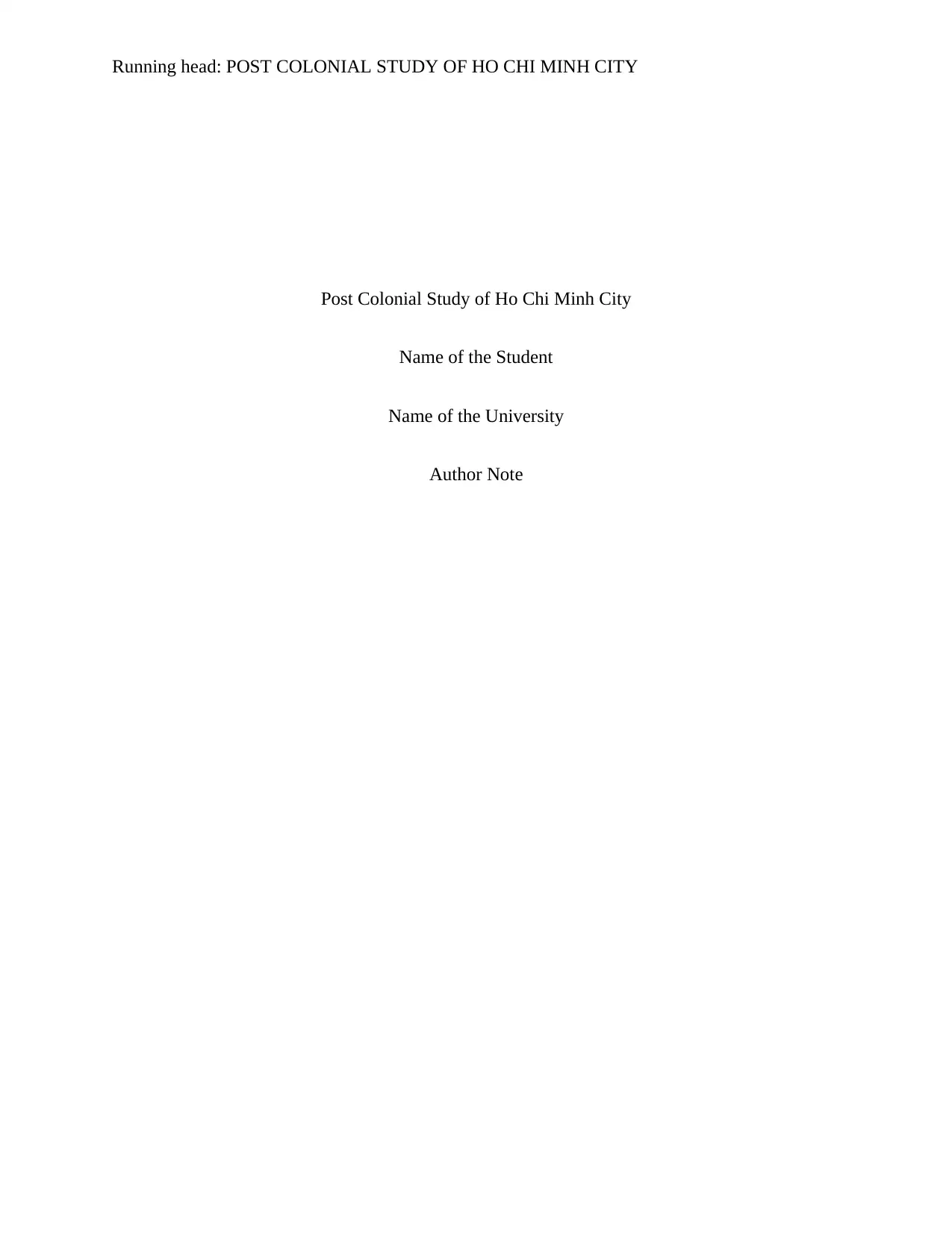
Running head: POST COLONIAL STUDY OF HO CHI MINH CITY
Post Colonial Study of Ho Chi Minh City
Name of the Student
Name of the University
Author Note
Post Colonial Study of Ho Chi Minh City
Name of the Student
Name of the University
Author Note
Secure Best Marks with AI Grader
Need help grading? Try our AI Grader for instant feedback on your assignments.
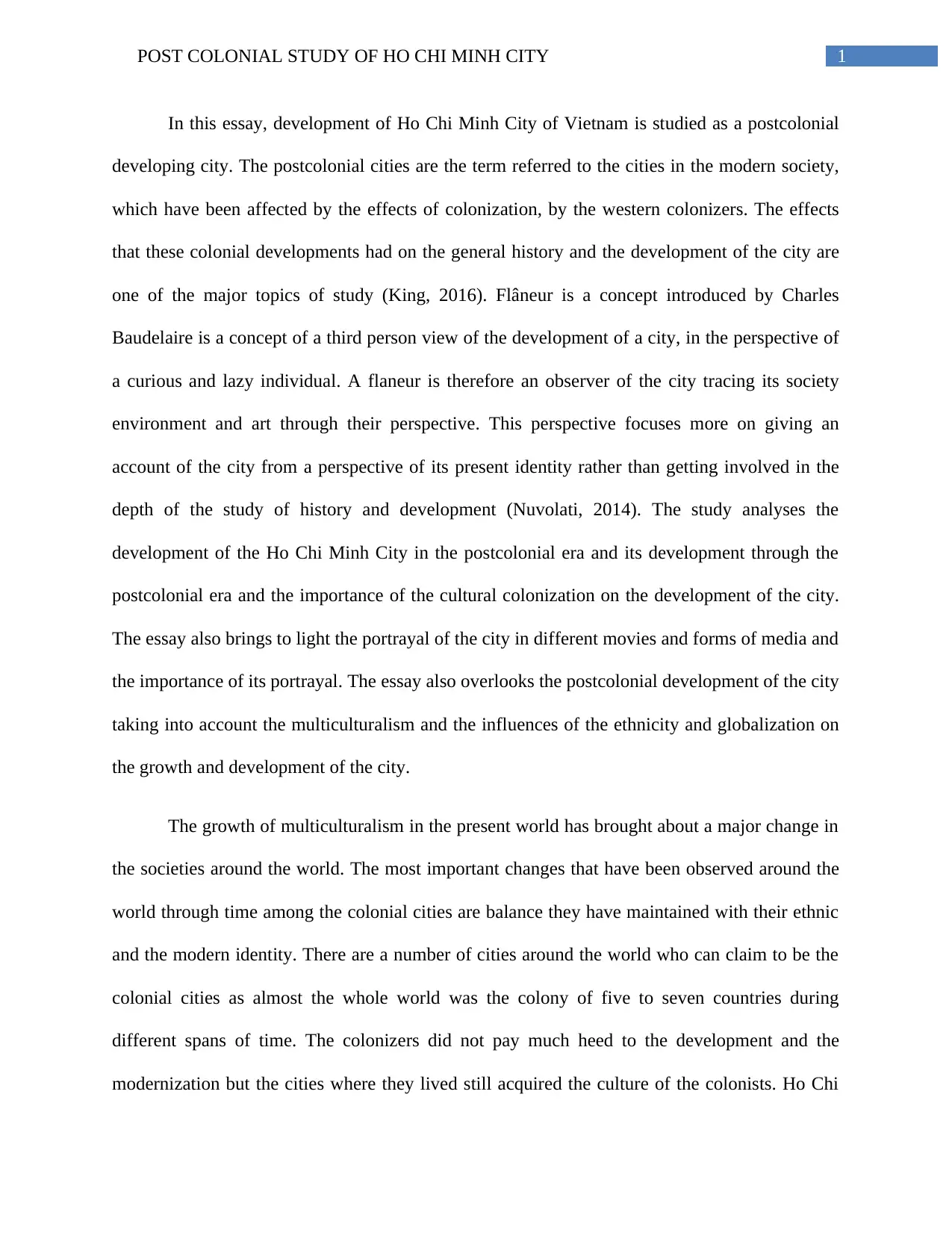
1POST COLONIAL STUDY OF HO CHI MINH CITY
In this essay, development of Ho Chi Minh City of Vietnam is studied as a postcolonial
developing city. The postcolonial cities are the term referred to the cities in the modern society,
which have been affected by the effects of colonization, by the western colonizers. The effects
that these colonial developments had on the general history and the development of the city are
one of the major topics of study (King, 2016). Flâneur is a concept introduced by Charles
Baudelaire is a concept of a third person view of the development of a city, in the perspective of
a curious and lazy individual. A flaneur is therefore an observer of the city tracing its society
environment and art through their perspective. This perspective focuses more on giving an
account of the city from a perspective of its present identity rather than getting involved in the
depth of the study of history and development (Nuvolati, 2014). The study analyses the
development of the Ho Chi Minh City in the postcolonial era and its development through the
postcolonial era and the importance of the cultural colonization on the development of the city.
The essay also brings to light the portrayal of the city in different movies and forms of media and
the importance of its portrayal. The essay also overlooks the postcolonial development of the city
taking into account the multiculturalism and the influences of the ethnicity and globalization on
the growth and development of the city.
The growth of multiculturalism in the present world has brought about a major change in
the societies around the world. The most important changes that have been observed around the
world through time among the colonial cities are balance they have maintained with their ethnic
and the modern identity. There are a number of cities around the world who can claim to be the
colonial cities as almost the whole world was the colony of five to seven countries during
different spans of time. The colonizers did not pay much heed to the development and the
modernization but the cities where they lived still acquired the culture of the colonists. Ho Chi
In this essay, development of Ho Chi Minh City of Vietnam is studied as a postcolonial
developing city. The postcolonial cities are the term referred to the cities in the modern society,
which have been affected by the effects of colonization, by the western colonizers. The effects
that these colonial developments had on the general history and the development of the city are
one of the major topics of study (King, 2016). Flâneur is a concept introduced by Charles
Baudelaire is a concept of a third person view of the development of a city, in the perspective of
a curious and lazy individual. A flaneur is therefore an observer of the city tracing its society
environment and art through their perspective. This perspective focuses more on giving an
account of the city from a perspective of its present identity rather than getting involved in the
depth of the study of history and development (Nuvolati, 2014). The study analyses the
development of the Ho Chi Minh City in the postcolonial era and its development through the
postcolonial era and the importance of the cultural colonization on the development of the city.
The essay also brings to light the portrayal of the city in different movies and forms of media and
the importance of its portrayal. The essay also overlooks the postcolonial development of the city
taking into account the multiculturalism and the influences of the ethnicity and globalization on
the growth and development of the city.
The growth of multiculturalism in the present world has brought about a major change in
the societies around the world. The most important changes that have been observed around the
world through time among the colonial cities are balance they have maintained with their ethnic
and the modern identity. There are a number of cities around the world who can claim to be the
colonial cities as almost the whole world was the colony of five to seven countries during
different spans of time. The colonizers did not pay much heed to the development and the
modernization but the cities where they lived still acquired the culture of the colonists. Ho Chi
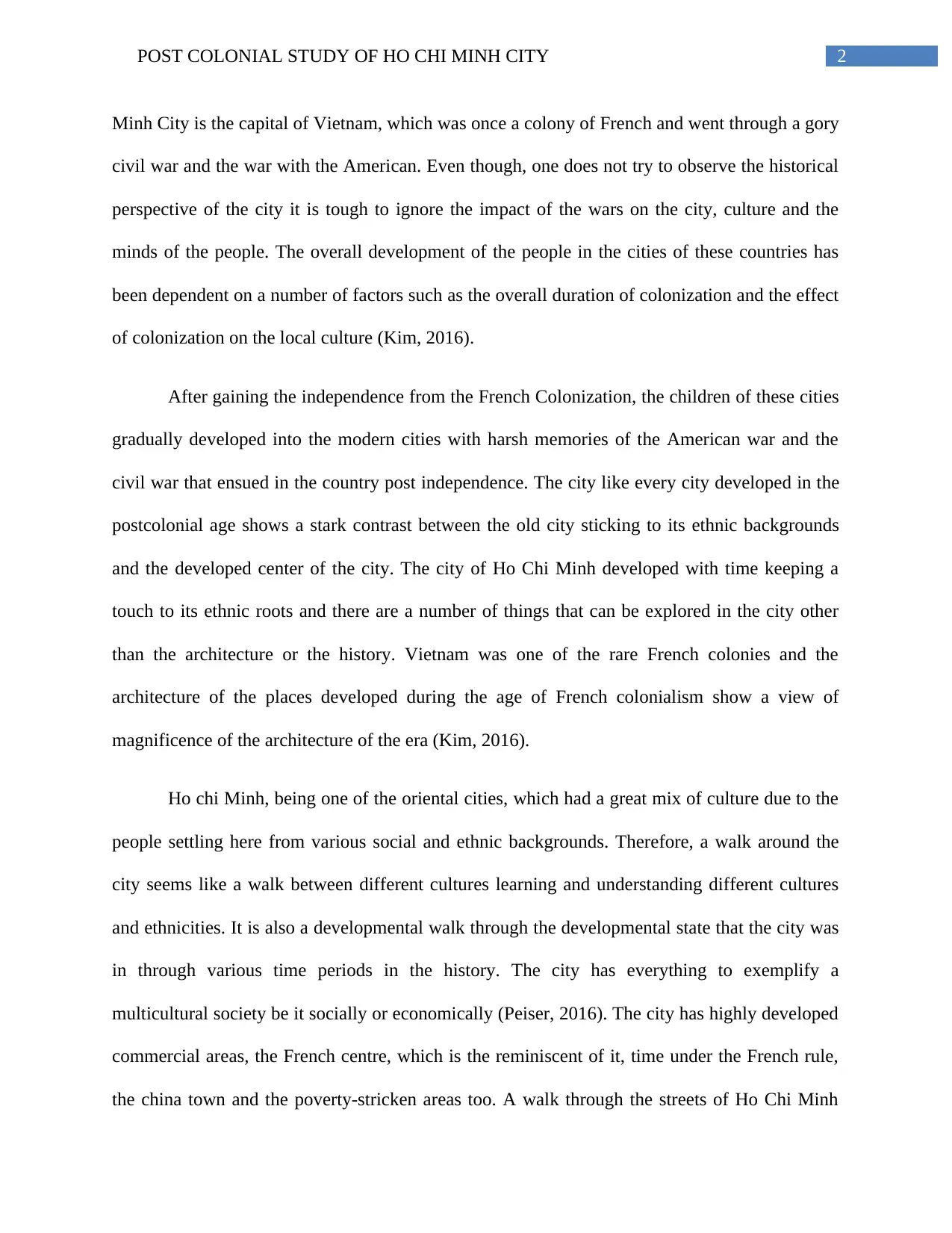
2POST COLONIAL STUDY OF HO CHI MINH CITY
Minh City is the capital of Vietnam, which was once a colony of French and went through a gory
civil war and the war with the American. Even though, one does not try to observe the historical
perspective of the city it is tough to ignore the impact of the wars on the city, culture and the
minds of the people. The overall development of the people in the cities of these countries has
been dependent on a number of factors such as the overall duration of colonization and the effect
of colonization on the local culture (Kim, 2016).
After gaining the independence from the French Colonization, the children of these cities
gradually developed into the modern cities with harsh memories of the American war and the
civil war that ensued in the country post independence. The city like every city developed in the
postcolonial age shows a stark contrast between the old city sticking to its ethnic backgrounds
and the developed center of the city. The city of Ho Chi Minh developed with time keeping a
touch to its ethnic roots and there are a number of things that can be explored in the city other
than the architecture or the history. Vietnam was one of the rare French colonies and the
architecture of the places developed during the age of French colonialism show a view of
magnificence of the architecture of the era (Kim, 2016).
Ho chi Minh, being one of the oriental cities, which had a great mix of culture due to the
people settling here from various social and ethnic backgrounds. Therefore, a walk around the
city seems like a walk between different cultures learning and understanding different cultures
and ethnicities. It is also a developmental walk through the developmental state that the city was
in through various time periods in the history. The city has everything to exemplify a
multicultural society be it socially or economically (Peiser, 2016). The city has highly developed
commercial areas, the French centre, which is the reminiscent of it, time under the French rule,
the china town and the poverty-stricken areas too. A walk through the streets of Ho Chi Minh
Minh City is the capital of Vietnam, which was once a colony of French and went through a gory
civil war and the war with the American. Even though, one does not try to observe the historical
perspective of the city it is tough to ignore the impact of the wars on the city, culture and the
minds of the people. The overall development of the people in the cities of these countries has
been dependent on a number of factors such as the overall duration of colonization and the effect
of colonization on the local culture (Kim, 2016).
After gaining the independence from the French Colonization, the children of these cities
gradually developed into the modern cities with harsh memories of the American war and the
civil war that ensued in the country post independence. The city like every city developed in the
postcolonial age shows a stark contrast between the old city sticking to its ethnic backgrounds
and the developed center of the city. The city of Ho Chi Minh developed with time keeping a
touch to its ethnic roots and there are a number of things that can be explored in the city other
than the architecture or the history. Vietnam was one of the rare French colonies and the
architecture of the places developed during the age of French colonialism show a view of
magnificence of the architecture of the era (Kim, 2016).
Ho chi Minh, being one of the oriental cities, which had a great mix of culture due to the
people settling here from various social and ethnic backgrounds. Therefore, a walk around the
city seems like a walk between different cultures learning and understanding different cultures
and ethnicities. It is also a developmental walk through the developmental state that the city was
in through various time periods in the history. The city has everything to exemplify a
multicultural society be it socially or economically (Peiser, 2016). The city has highly developed
commercial areas, the French centre, which is the reminiscent of it, time under the French rule,
the china town and the poverty-stricken areas too. A walk through the streets of Ho Chi Minh
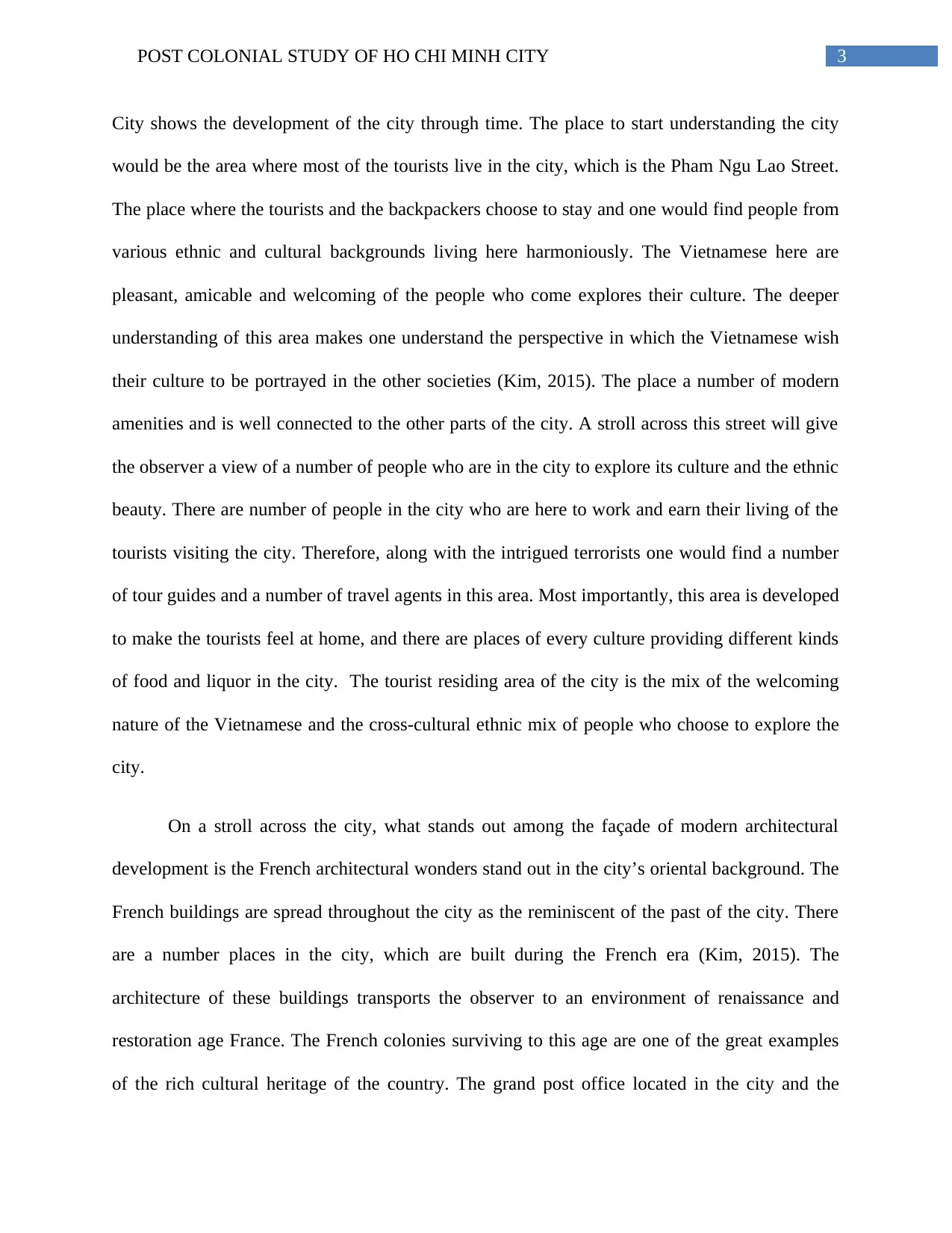
3POST COLONIAL STUDY OF HO CHI MINH CITY
City shows the development of the city through time. The place to start understanding the city
would be the area where most of the tourists live in the city, which is the Pham Ngu Lao Street.
The place where the tourists and the backpackers choose to stay and one would find people from
various ethnic and cultural backgrounds living here harmoniously. The Vietnamese here are
pleasant, amicable and welcoming of the people who come explores their culture. The deeper
understanding of this area makes one understand the perspective in which the Vietnamese wish
their culture to be portrayed in the other societies (Kim, 2015). The place a number of modern
amenities and is well connected to the other parts of the city. A stroll across this street will give
the observer a view of a number of people who are in the city to explore its culture and the ethnic
beauty. There are number of people in the city who are here to work and earn their living of the
tourists visiting the city. Therefore, along with the intrigued terrorists one would find a number
of tour guides and a number of travel agents in this area. Most importantly, this area is developed
to make the tourists feel at home, and there are places of every culture providing different kinds
of food and liquor in the city. The tourist residing area of the city is the mix of the welcoming
nature of the Vietnamese and the cross-cultural ethnic mix of people who choose to explore the
city.
On a stroll across the city, what stands out among the façade of modern architectural
development is the French architectural wonders stand out in the city’s oriental background. The
French buildings are spread throughout the city as the reminiscent of the past of the city. There
are a number places in the city, which are built during the French era (Kim, 2015). The
architecture of these buildings transports the observer to an environment of renaissance and
restoration age France. The French colonies surviving to this age are one of the great examples
of the rich cultural heritage of the country. The grand post office located in the city and the
City shows the development of the city through time. The place to start understanding the city
would be the area where most of the tourists live in the city, which is the Pham Ngu Lao Street.
The place where the tourists and the backpackers choose to stay and one would find people from
various ethnic and cultural backgrounds living here harmoniously. The Vietnamese here are
pleasant, amicable and welcoming of the people who come explores their culture. The deeper
understanding of this area makes one understand the perspective in which the Vietnamese wish
their culture to be portrayed in the other societies (Kim, 2015). The place a number of modern
amenities and is well connected to the other parts of the city. A stroll across this street will give
the observer a view of a number of people who are in the city to explore its culture and the ethnic
beauty. There are number of people in the city who are here to work and earn their living of the
tourists visiting the city. Therefore, along with the intrigued terrorists one would find a number
of tour guides and a number of travel agents in this area. Most importantly, this area is developed
to make the tourists feel at home, and there are places of every culture providing different kinds
of food and liquor in the city. The tourist residing area of the city is the mix of the welcoming
nature of the Vietnamese and the cross-cultural ethnic mix of people who choose to explore the
city.
On a stroll across the city, what stands out among the façade of modern architectural
development is the French architectural wonders stand out in the city’s oriental background. The
French buildings are spread throughout the city as the reminiscent of the past of the city. There
are a number places in the city, which are built during the French era (Kim, 2015). The
architecture of these buildings transports the observer to an environment of renaissance and
restoration age France. The French colonies surviving to this age are one of the great examples
of the rich cultural heritage of the country. The grand post office located in the city and the
Secure Best Marks with AI Grader
Need help grading? Try our AI Grader for instant feedback on your assignments.
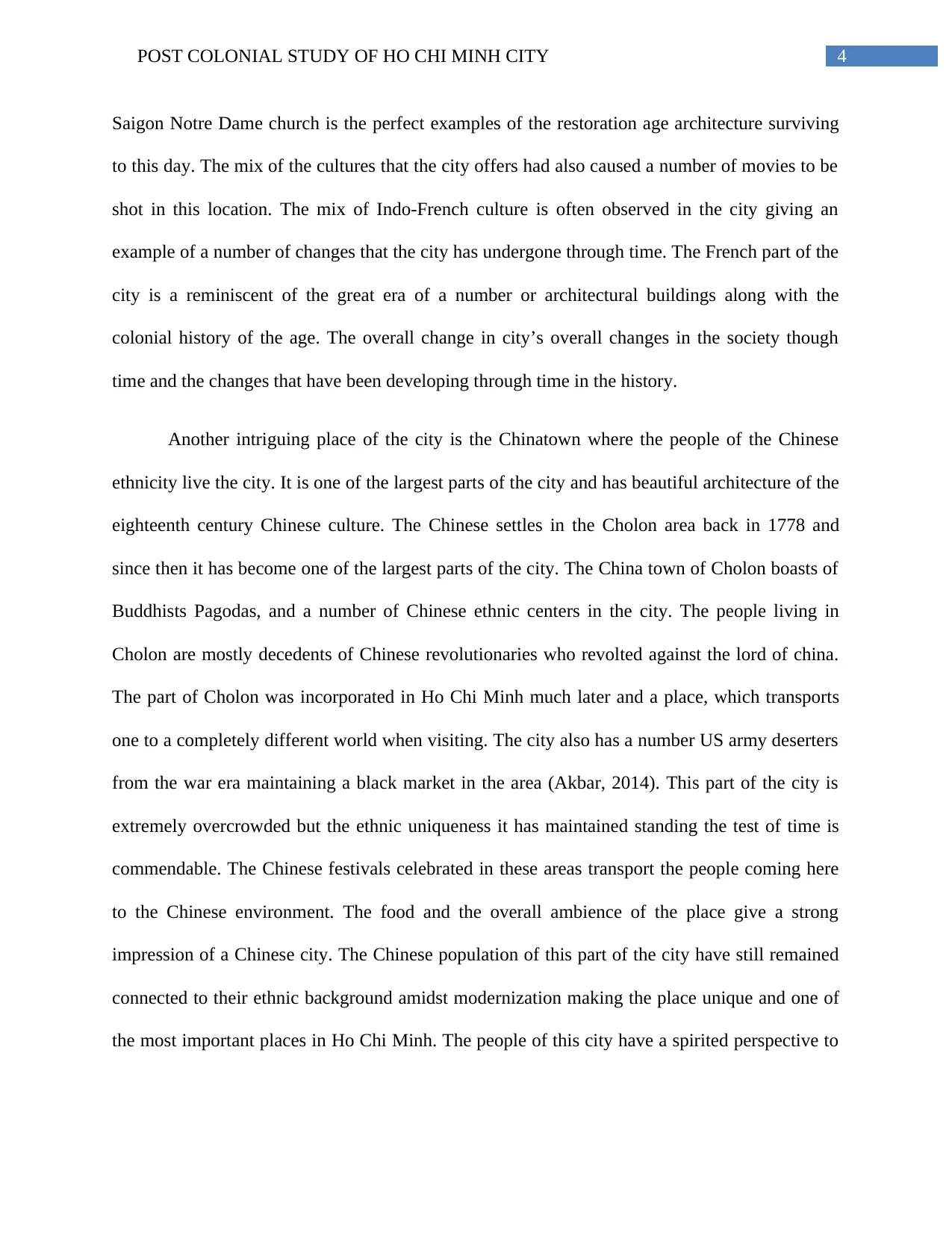
4POST COLONIAL STUDY OF HO CHI MINH CITY
Saigon Notre Dame church is the perfect examples of the restoration age architecture surviving
to this day. The mix of the cultures that the city offers had also caused a number of movies to be
shot in this location. The mix of Indo-French culture is often observed in the city giving an
example of a number of changes that the city has undergone through time. The French part of the
city is a reminiscent of the great era of a number or architectural buildings along with the
colonial history of the age. The overall change in city’s overall changes in the society though
time and the changes that have been developing through time in the history.
Another intriguing place of the city is the Chinatown where the people of the Chinese
ethnicity live the city. It is one of the largest parts of the city and has beautiful architecture of the
eighteenth century Chinese culture. The Chinese settles in the Cholon area back in 1778 and
since then it has become one of the largest parts of the city. The China town of Cholon boasts of
Buddhists Pagodas, and a number of Chinese ethnic centers in the city. The people living in
Cholon are mostly decedents of Chinese revolutionaries who revolted against the lord of china.
The part of Cholon was incorporated in Ho Chi Minh much later and a place, which transports
one to a completely different world when visiting. The city also has a number US army deserters
from the war era maintaining a black market in the area (Akbar, 2014). This part of the city is
extremely overcrowded but the ethnic uniqueness it has maintained standing the test of time is
commendable. The Chinese festivals celebrated in these areas transport the people coming here
to the Chinese environment. The food and the overall ambience of the place give a strong
impression of a Chinese city. The Chinese population of this part of the city have still remained
connected to their ethnic background amidst modernization making the place unique and one of
the most important places in Ho Chi Minh. The people of this city have a spirited perspective to
Saigon Notre Dame church is the perfect examples of the restoration age architecture surviving
to this day. The mix of the cultures that the city offers had also caused a number of movies to be
shot in this location. The mix of Indo-French culture is often observed in the city giving an
example of a number of changes that the city has undergone through time. The French part of the
city is a reminiscent of the great era of a number or architectural buildings along with the
colonial history of the age. The overall change in city’s overall changes in the society though
time and the changes that have been developing through time in the history.
Another intriguing place of the city is the Chinatown where the people of the Chinese
ethnicity live the city. It is one of the largest parts of the city and has beautiful architecture of the
eighteenth century Chinese culture. The Chinese settles in the Cholon area back in 1778 and
since then it has become one of the largest parts of the city. The China town of Cholon boasts of
Buddhists Pagodas, and a number of Chinese ethnic centers in the city. The people living in
Cholon are mostly decedents of Chinese revolutionaries who revolted against the lord of china.
The part of Cholon was incorporated in Ho Chi Minh much later and a place, which transports
one to a completely different world when visiting. The city also has a number US army deserters
from the war era maintaining a black market in the area (Akbar, 2014). This part of the city is
extremely overcrowded but the ethnic uniqueness it has maintained standing the test of time is
commendable. The Chinese festivals celebrated in these areas transport the people coming here
to the Chinese environment. The food and the overall ambience of the place give a strong
impression of a Chinese city. The Chinese population of this part of the city have still remained
connected to their ethnic background amidst modernization making the place unique and one of
the most important places in Ho Chi Minh. The people of this city have a spirited perspective to
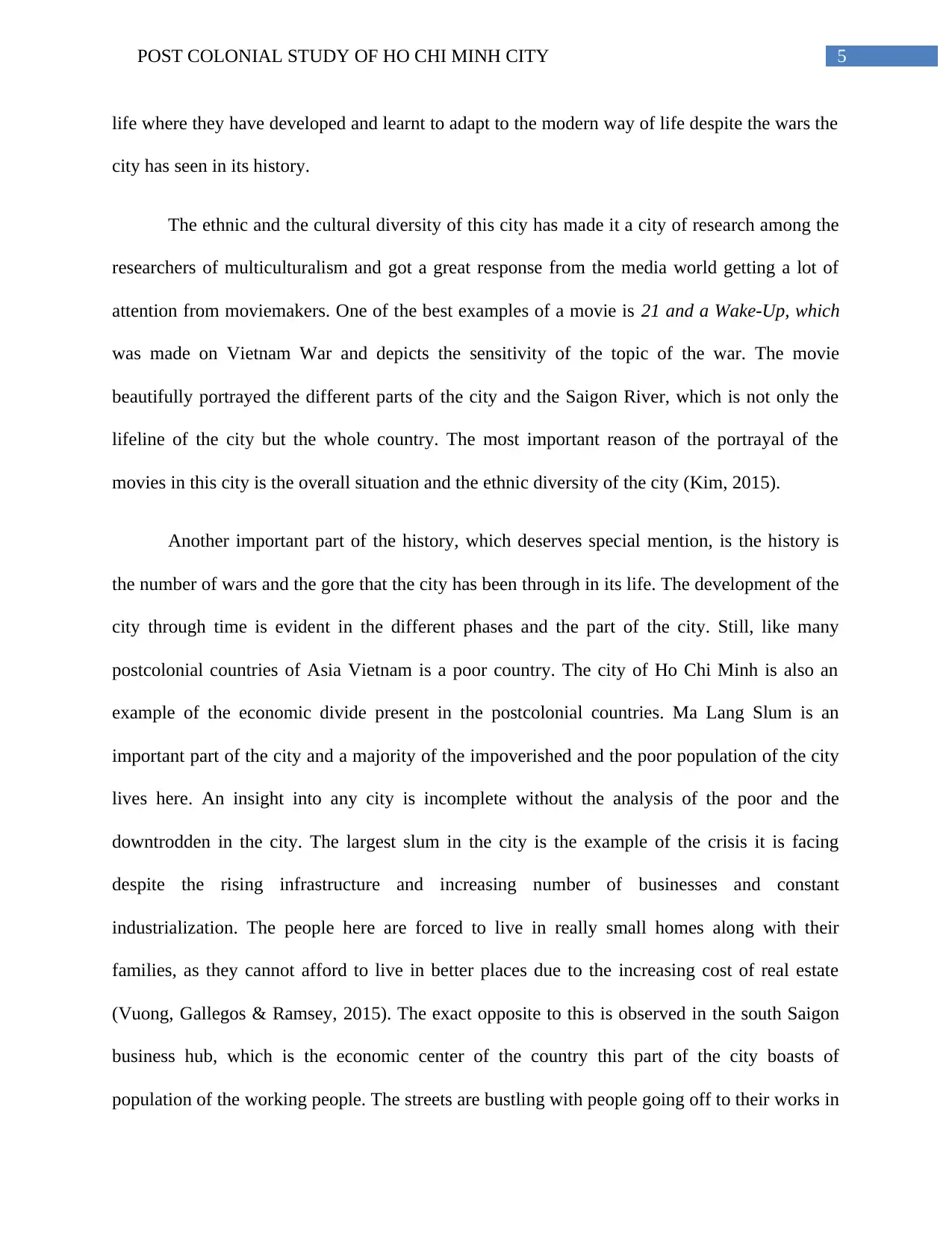
5POST COLONIAL STUDY OF HO CHI MINH CITY
life where they have developed and learnt to adapt to the modern way of life despite the wars the
city has seen in its history.
The ethnic and the cultural diversity of this city has made it a city of research among the
researchers of multiculturalism and got a great response from the media world getting a lot of
attention from moviemakers. One of the best examples of a movie is 21 and a Wake-Up, which
was made on Vietnam War and depicts the sensitivity of the topic of the war. The movie
beautifully portrayed the different parts of the city and the Saigon River, which is not only the
lifeline of the city but the whole country. The most important reason of the portrayal of the
movies in this city is the overall situation and the ethnic diversity of the city (Kim, 2015).
Another important part of the history, which deserves special mention, is the history is
the number of wars and the gore that the city has been through in its life. The development of the
city through time is evident in the different phases and the part of the city. Still, like many
postcolonial countries of Asia Vietnam is a poor country. The city of Ho Chi Minh is also an
example of the economic divide present in the postcolonial countries. Ma Lang Slum is an
important part of the city and a majority of the impoverished and the poor population of the city
lives here. An insight into any city is incomplete without the analysis of the poor and the
downtrodden in the city. The largest slum in the city is the example of the crisis it is facing
despite the rising infrastructure and increasing number of businesses and constant
industrialization. The people here are forced to live in really small homes along with their
families, as they cannot afford to live in better places due to the increasing cost of real estate
(Vuong, Gallegos & Ramsey, 2015). The exact opposite to this is observed in the south Saigon
business hub, which is the economic center of the country this part of the city boasts of
population of the working people. The streets are bustling with people going off to their works in
life where they have developed and learnt to adapt to the modern way of life despite the wars the
city has seen in its history.
The ethnic and the cultural diversity of this city has made it a city of research among the
researchers of multiculturalism and got a great response from the media world getting a lot of
attention from moviemakers. One of the best examples of a movie is 21 and a Wake-Up, which
was made on Vietnam War and depicts the sensitivity of the topic of the war. The movie
beautifully portrayed the different parts of the city and the Saigon River, which is not only the
lifeline of the city but the whole country. The most important reason of the portrayal of the
movies in this city is the overall situation and the ethnic diversity of the city (Kim, 2015).
Another important part of the history, which deserves special mention, is the history is
the number of wars and the gore that the city has been through in its life. The development of the
city through time is evident in the different phases and the part of the city. Still, like many
postcolonial countries of Asia Vietnam is a poor country. The city of Ho Chi Minh is also an
example of the economic divide present in the postcolonial countries. Ma Lang Slum is an
important part of the city and a majority of the impoverished and the poor population of the city
lives here. An insight into any city is incomplete without the analysis of the poor and the
downtrodden in the city. The largest slum in the city is the example of the crisis it is facing
despite the rising infrastructure and increasing number of businesses and constant
industrialization. The people here are forced to live in really small homes along with their
families, as they cannot afford to live in better places due to the increasing cost of real estate
(Vuong, Gallegos & Ramsey, 2015). The exact opposite to this is observed in the south Saigon
business hub, which is the economic center of the country this part of the city boasts of
population of the working people. The streets are bustling with people going off to their works in
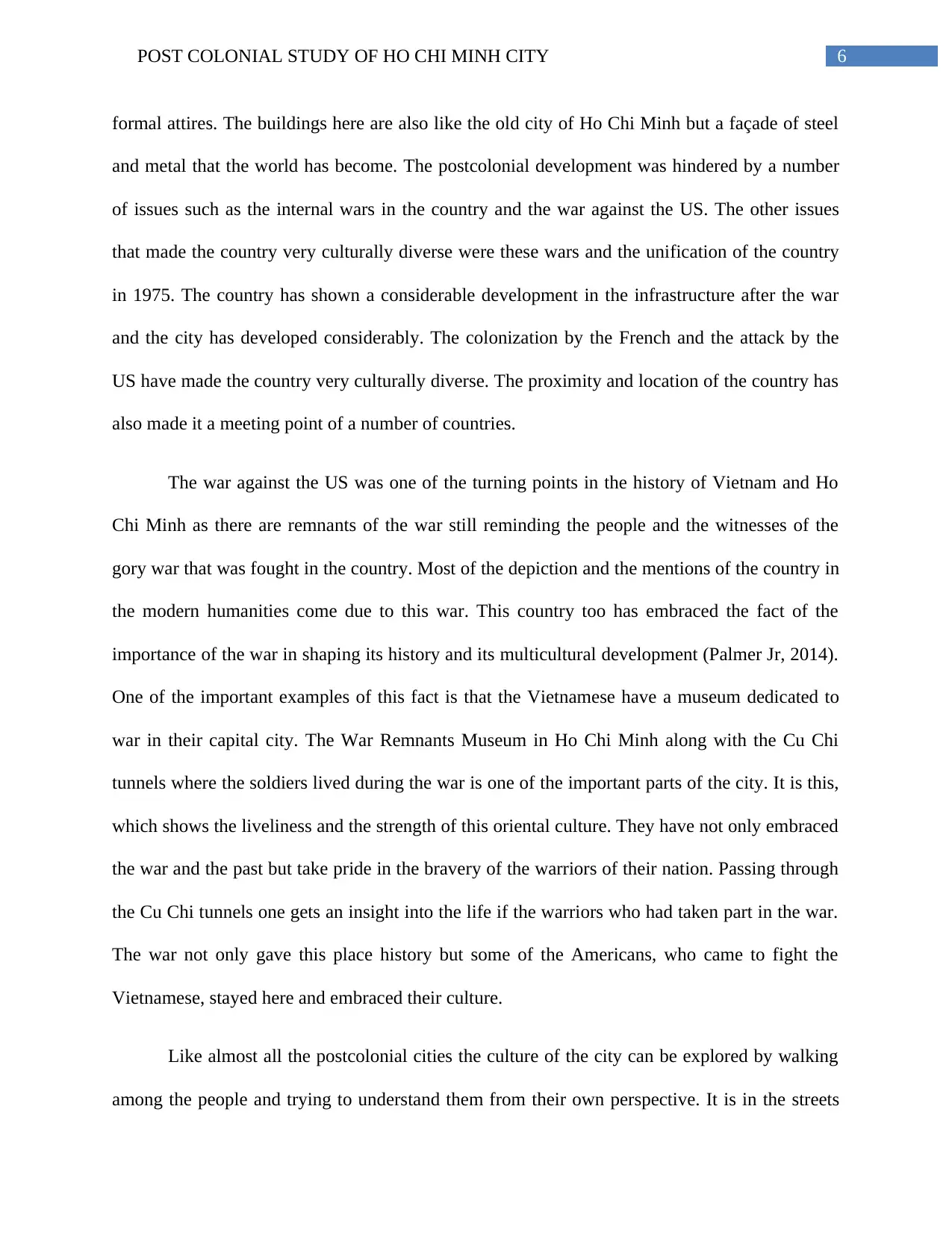
6POST COLONIAL STUDY OF HO CHI MINH CITY
formal attires. The buildings here are also like the old city of Ho Chi Minh but a façade of steel
and metal that the world has become. The postcolonial development was hindered by a number
of issues such as the internal wars in the country and the war against the US. The other issues
that made the country very culturally diverse were these wars and the unification of the country
in 1975. The country has shown a considerable development in the infrastructure after the war
and the city has developed considerably. The colonization by the French and the attack by the
US have made the country very culturally diverse. The proximity and location of the country has
also made it a meeting point of a number of countries.
The war against the US was one of the turning points in the history of Vietnam and Ho
Chi Minh as there are remnants of the war still reminding the people and the witnesses of the
gory war that was fought in the country. Most of the depiction and the mentions of the country in
the modern humanities come due to this war. This country too has embraced the fact of the
importance of the war in shaping its history and its multicultural development (Palmer Jr, 2014).
One of the important examples of this fact is that the Vietnamese have a museum dedicated to
war in their capital city. The War Remnants Museum in Ho Chi Minh along with the Cu Chi
tunnels where the soldiers lived during the war is one of the important parts of the city. It is this,
which shows the liveliness and the strength of this oriental culture. They have not only embraced
the war and the past but take pride in the bravery of the warriors of their nation. Passing through
the Cu Chi tunnels one gets an insight into the life if the warriors who had taken part in the war.
The war not only gave this place history but some of the Americans, who came to fight the
Vietnamese, stayed here and embraced their culture.
Like almost all the postcolonial cities the culture of the city can be explored by walking
among the people and trying to understand them from their own perspective. It is in the streets
formal attires. The buildings here are also like the old city of Ho Chi Minh but a façade of steel
and metal that the world has become. The postcolonial development was hindered by a number
of issues such as the internal wars in the country and the war against the US. The other issues
that made the country very culturally diverse were these wars and the unification of the country
in 1975. The country has shown a considerable development in the infrastructure after the war
and the city has developed considerably. The colonization by the French and the attack by the
US have made the country very culturally diverse. The proximity and location of the country has
also made it a meeting point of a number of countries.
The war against the US was one of the turning points in the history of Vietnam and Ho
Chi Minh as there are remnants of the war still reminding the people and the witnesses of the
gory war that was fought in the country. Most of the depiction and the mentions of the country in
the modern humanities come due to this war. This country too has embraced the fact of the
importance of the war in shaping its history and its multicultural development (Palmer Jr, 2014).
One of the important examples of this fact is that the Vietnamese have a museum dedicated to
war in their capital city. The War Remnants Museum in Ho Chi Minh along with the Cu Chi
tunnels where the soldiers lived during the war is one of the important parts of the city. It is this,
which shows the liveliness and the strength of this oriental culture. They have not only embraced
the war and the past but take pride in the bravery of the warriors of their nation. Passing through
the Cu Chi tunnels one gets an insight into the life if the warriors who had taken part in the war.
The war not only gave this place history but some of the Americans, who came to fight the
Vietnamese, stayed here and embraced their culture.
Like almost all the postcolonial cities the culture of the city can be explored by walking
among the people and trying to understand them from their own perspective. It is in the streets
Paraphrase This Document
Need a fresh take? Get an instant paraphrase of this document with our AI Paraphraser
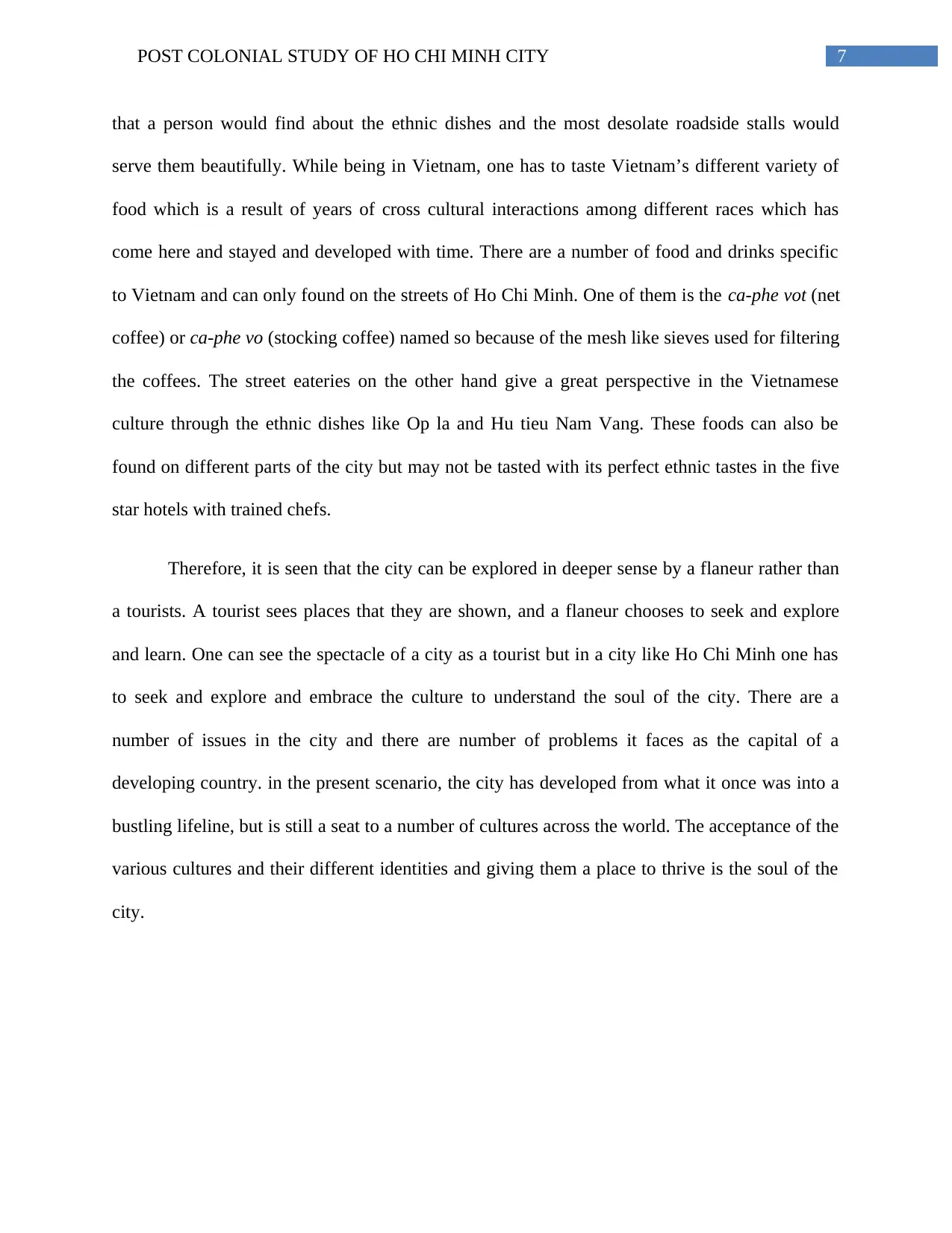
7POST COLONIAL STUDY OF HO CHI MINH CITY
that a person would find about the ethnic dishes and the most desolate roadside stalls would
serve them beautifully. While being in Vietnam, one has to taste Vietnam’s different variety of
food which is a result of years of cross cultural interactions among different races which has
come here and stayed and developed with time. There are a number of food and drinks specific
to Vietnam and can only found on the streets of Ho Chi Minh. One of them is the ca-phe vot (net
coffee) or ca-phe vo (stocking coffee) named so because of the mesh like sieves used for filtering
the coffees. The street eateries on the other hand give a great perspective in the Vietnamese
culture through the ethnic dishes like Op la and Hu tieu Nam Vang. These foods can also be
found on different parts of the city but may not be tasted with its perfect ethnic tastes in the five
star hotels with trained chefs.
Therefore, it is seen that the city can be explored in deeper sense by a flaneur rather than
a tourists. A tourist sees places that they are shown, and a flaneur chooses to seek and explore
and learn. One can see the spectacle of a city as a tourist but in a city like Ho Chi Minh one has
to seek and explore and embrace the culture to understand the soul of the city. There are a
number of issues in the city and there are number of problems it faces as the capital of a
developing country. in the present scenario, the city has developed from what it once was into a
bustling lifeline, but is still a seat to a number of cultures across the world. The acceptance of the
various cultures and their different identities and giving them a place to thrive is the soul of the
city.
that a person would find about the ethnic dishes and the most desolate roadside stalls would
serve them beautifully. While being in Vietnam, one has to taste Vietnam’s different variety of
food which is a result of years of cross cultural interactions among different races which has
come here and stayed and developed with time. There are a number of food and drinks specific
to Vietnam and can only found on the streets of Ho Chi Minh. One of them is the ca-phe vot (net
coffee) or ca-phe vo (stocking coffee) named so because of the mesh like sieves used for filtering
the coffees. The street eateries on the other hand give a great perspective in the Vietnamese
culture through the ethnic dishes like Op la and Hu tieu Nam Vang. These foods can also be
found on different parts of the city but may not be tasted with its perfect ethnic tastes in the five
star hotels with trained chefs.
Therefore, it is seen that the city can be explored in deeper sense by a flaneur rather than
a tourists. A tourist sees places that they are shown, and a flaneur chooses to seek and explore
and learn. One can see the spectacle of a city as a tourist but in a city like Ho Chi Minh one has
to seek and explore and embrace the culture to understand the soul of the city. There are a
number of issues in the city and there are number of problems it faces as the capital of a
developing country. in the present scenario, the city has developed from what it once was into a
bustling lifeline, but is still a seat to a number of cultures across the world. The acceptance of the
various cultures and their different identities and giving them a place to thrive is the soul of the
city.
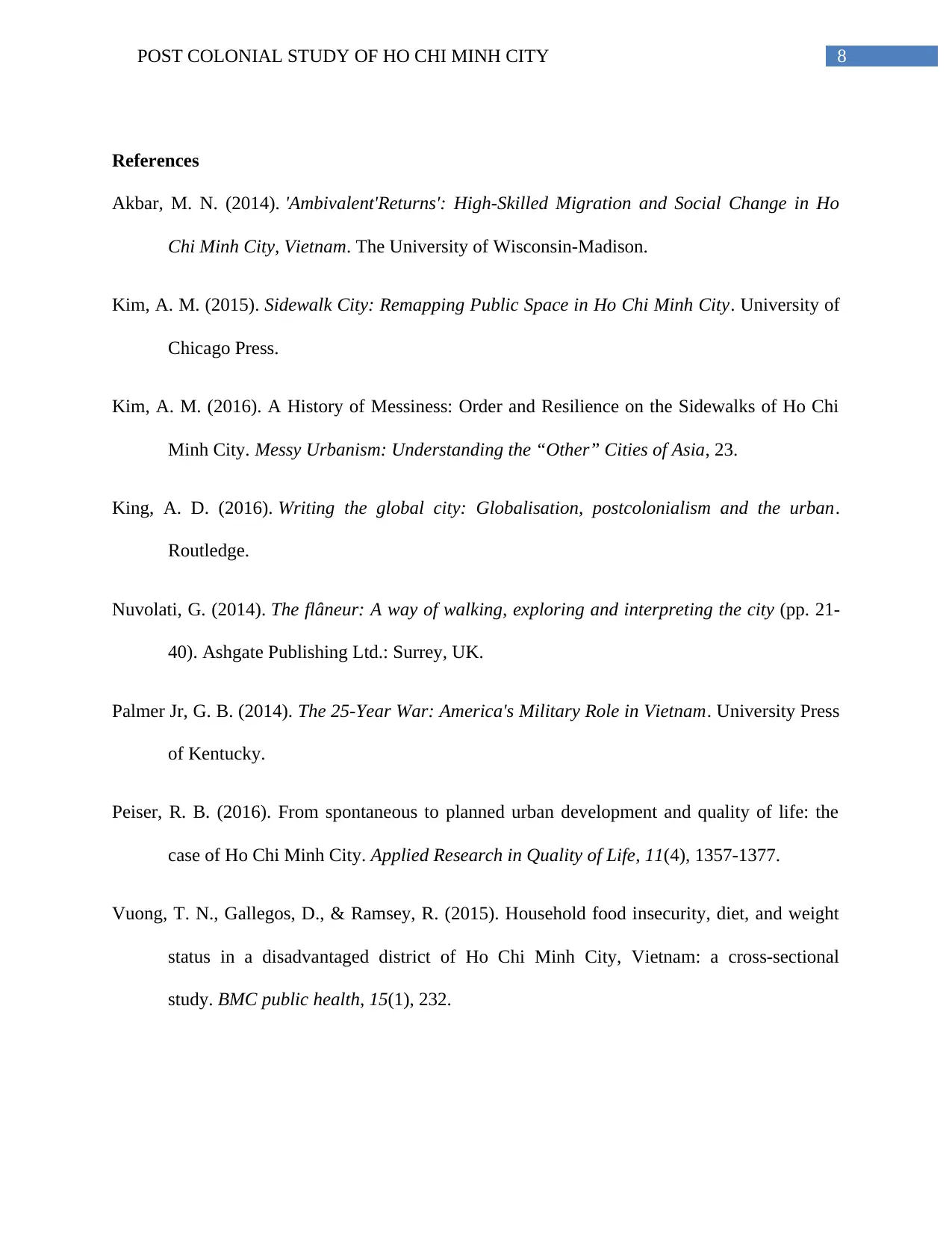
8POST COLONIAL STUDY OF HO CHI MINH CITY
References
Akbar, M. N. (2014). 'Ambivalent'Returns': High-Skilled Migration and Social Change in Ho
Chi Minh City, Vietnam. The University of Wisconsin-Madison.
Kim, A. M. (2015). Sidewalk City: Remapping Public Space in Ho Chi Minh City. University of
Chicago Press.
Kim, A. M. (2016). A History of Messiness: Order and Resilience on the Sidewalks of Ho Chi
Minh City. Messy Urbanism: Understanding the “Other” Cities of Asia, 23.
King, A. D. (2016). Writing the global city: Globalisation, postcolonialism and the urban.
Routledge.
Nuvolati, G. (2014). The flâneur: A way of walking, exploring and interpreting the city (pp. 21-
40). Ashgate Publishing Ltd.: Surrey, UK.
Palmer Jr, G. B. (2014). The 25-Year War: America's Military Role in Vietnam. University Press
of Kentucky.
Peiser, R. B. (2016). From spontaneous to planned urban development and quality of life: the
case of Ho Chi Minh City. Applied Research in Quality of Life, 11(4), 1357-1377.
Vuong, T. N., Gallegos, D., & Ramsey, R. (2015). Household food insecurity, diet, and weight
status in a disadvantaged district of Ho Chi Minh City, Vietnam: a cross-sectional
study. BMC public health, 15(1), 232.
References
Akbar, M. N. (2014). 'Ambivalent'Returns': High-Skilled Migration and Social Change in Ho
Chi Minh City, Vietnam. The University of Wisconsin-Madison.
Kim, A. M. (2015). Sidewalk City: Remapping Public Space in Ho Chi Minh City. University of
Chicago Press.
Kim, A. M. (2016). A History of Messiness: Order and Resilience on the Sidewalks of Ho Chi
Minh City. Messy Urbanism: Understanding the “Other” Cities of Asia, 23.
King, A. D. (2016). Writing the global city: Globalisation, postcolonialism and the urban.
Routledge.
Nuvolati, G. (2014). The flâneur: A way of walking, exploring and interpreting the city (pp. 21-
40). Ashgate Publishing Ltd.: Surrey, UK.
Palmer Jr, G. B. (2014). The 25-Year War: America's Military Role in Vietnam. University Press
of Kentucky.
Peiser, R. B. (2016). From spontaneous to planned urban development and quality of life: the
case of Ho Chi Minh City. Applied Research in Quality of Life, 11(4), 1357-1377.
Vuong, T. N., Gallegos, D., & Ramsey, R. (2015). Household food insecurity, diet, and weight
status in a disadvantaged district of Ho Chi Minh City, Vietnam: a cross-sectional
study. BMC public health, 15(1), 232.
1 out of 9
Related Documents
Your All-in-One AI-Powered Toolkit for Academic Success.
+13062052269
info@desklib.com
Available 24*7 on WhatsApp / Email
![[object Object]](/_next/static/media/star-bottom.7253800d.svg)
Unlock your academic potential
© 2024 | Zucol Services PVT LTD | All rights reserved.




